Clothing in Ancient Greece was primarily homemade, and the fabrics could be used as garments, shrouds, or blankets. Both men and women wore two main g: aGreece that consisted of a tunic and a cloak.
Both those pieces were floor-length while men wore a tunic similar to that worn by the women; however, primarily knee-length.
The Greeks wore light clothes for most of the year as the climate used to be hot. Clothes were secured by ornamental pins on the shoulder and a belt or a sash at the waist.
Women wore necklaces, earrings, and bracelets made of gold and silver. They wore a large cloak over their regular clothing and leather shoes during the winter.
The most common colors were violet, green, and grey, while checks included wavy lines, stripes, and floral designs. The Greek Gods and Goddesses also preferred these clothing Greek Gods and Goddesses.
The top 10 most famous ancient Greek outfits are described below:
What was clothing like in ancient Greece?
Content
In ancient Greece, clothing included chitons, peplos, himation, and chlamys. Most of them were wrapped around the shoulder and pinned together with pins and brooches.
Who made clothes in ancient Greece?
Slaves and women usually made clothes. The clothes were costly; hence, most of them were homemade.
What was the clothing in ancient Greece made of?
The temperature was scorching most of the year, so Greeks wore clothes made out of light fabrics. During the summer, they wore linen fabrics, and during the winter, they wore woolen garments.
What colors were commonly used in clothing in ancient Greece?
The Greeks used bright colors such as green, indigo, yellow, violet, and dark red. They also included earthy colors in clothing.
10. Chiton

Source: Wikimedia Common
The chiton, a sleeveless shirt, was very common in the Archaic and Hellenistic periods.
Chiton could be worn in various ways, but the most common was draping it wound the body with the placement of a broach on the shoulder and putting a belt around the waist.
There were mainly two types of chiton. One was the Doric chiton ( sleeveless ) made with linen and pinned around the shoulder.
The other was an Ionic chiton ( with sleeves ), made with a fabric or wool and pinned to the wrist from the neck.
Ionic chitons became more famous, especially in men, around the Archaic period. These chitons were preferred mainly by the people belonging to the upper class, including actors, priests, and senates, whereas the shorter chitons were worn by Athletes, warriors, and slaves.
9. Peplos
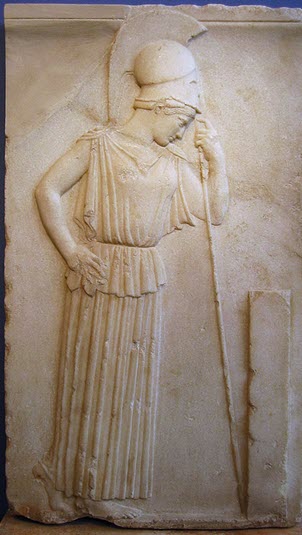
Source: Wikimedia Common
Peplos was a square piece of cloth worn over the chiton by women. It was a body-length garment, the top-third of which was folded over and pinned at both the shoulders, leaving it open one side.
The women folded the upper part down to the waist, forming an Apotygma. Sometimes it was worn as an alternative to chiton. When worn with a chiton, a belt was used to fasten the folds at the waist.
Peplos was the most famous clothing among women during the middle of the classical era around 500 BC. Mostly, girls were chosen to make peploi out of a large piece of fabric during ancient Greek rituals which took about nine months to complete.
8. Chlamys
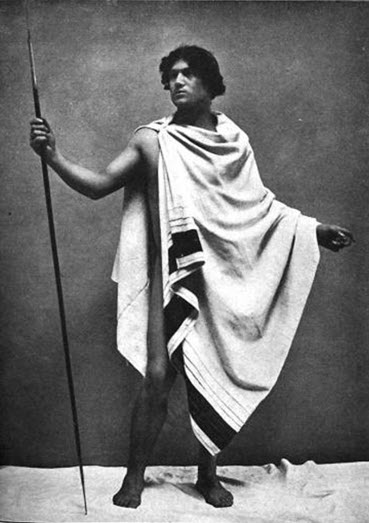
Source: Wikimedia Common
Chlamys was the modern-day cloak in the ancient Greek version. They made it from a seamless rectangular piece of woolen material. It was about the size of a blanket, and men wore it for military or hunting purposes.
They initially wore it by wrapping it around the waist, similar to a loincloth. However, it was worn over the waist by the end of the fifth century.
It was tied at the right shoulder with a brooch when worn as a cloak over the clothing. However, it was mainly worn as a sole item of clothing by young soldiers and messengers.
7. Himation
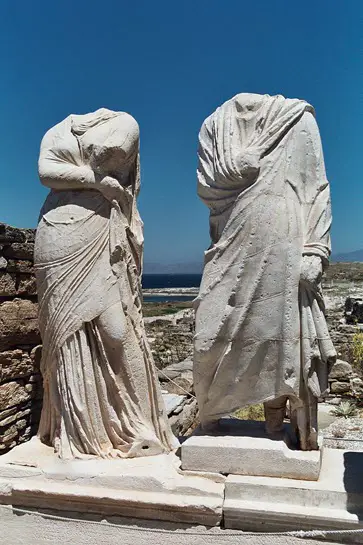
Source: Wikimedia Common
The Himation was an outer garment worn over chiton or peplos that originated during the 6th Century BC. It was one of the outfits which were not meant for a particular gender and could be worn by males and females.
It was made of a heavy rectangular material passed under the left arm and secured at the right shoulder. The cloak, too, would be twisted around a strap that also passed under the left arm and attached over the right shoulder.
Pottery inscription displays were covered with eye-catching colors and unique designs.
These were used chiefly on long journeys. Greek women wore them in many styles. The symmetrical style was the most popular one, which was used as a large veil.
A baggier himation was worn during winter. It could be pulled up over the head to cover the person in case of situations of emotion or shame. Women also wore a shawl called an epiblema.
To make the outfit taste more of a higher level, the edges would not be dragged on the floor or on the surface.
6. Nudity

Source: Wikimedia Common
Spartan men were seen doing the physical training and events naked as they had rough training. Also, the women were occasionally seen naked, especially during festivals and events along with men. Hence, nudity was taken as an uncommon trend in Ancient Greece.
Male nudity, on the other hand, had to follow some systematic rules. Only male athletes were allowed to participate in Olympics naked. For men, artists used nudity to portray various roles of men, from heroism to state of defeat.
Men would stride around naked, free of their togas in the bedroom and at parties called symposia. However, going around town naked, riding horses nude, and going to the battles naked was not an option. Nakedness during combat was suicidal.
5. Sandals

Source: Wikimedia Common
Sandals and shoes, before the Middle Ages, were worn based on practicality rather than to maintain a style or a trend. Both men and women wore slippers, sandals, and shoes with a soft liner.
They preferred walking around barefoot at home but preferred wearing a sandal made up of leather, named carbatine while walking outside or traveling.
Cothurnus was another footwear piece that was similar to a boot. Like Carbatine, it was made out of piece of leather and with a red-colored strap on the front.
However, this piece would cover up most of the portion of the leg and also had a thick sole compared to the Carbatine.
4. The Veil
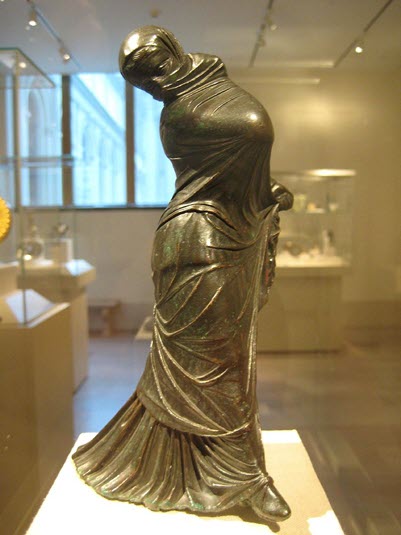
Source: Wikimedia Common
Ancient Greek women wore veils routinely, and classical Greek statues depicted women with their heads and faces covered by a veil. Wearing veils was considered a sign of respectability and high status.
Assyria had enforced laws regarding which women must and must not wear a veil based on their class, rank, and occupation in society. On the same lines, female slaves and prostitutes were forbidden to wear a veil and faced penalties if they did so.
Veils also acted as a way for women to express themselves and acquire control over their movement and status among men. Lysistrata women used veils to manipulate the sexual allure and send commanding sexual signals despite its intent of female concealment.
However, the veil supported the idea of female modesty, chastity, silence, and invisibility, eventually contributing to female separation and seclusion.
3. Epiblema
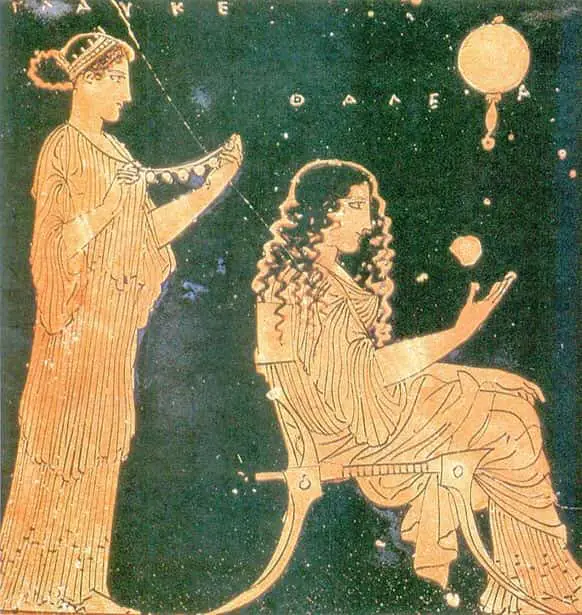
Source: Wikimedia Common
Epiblema is the Greek term for a shawl and is worn on to pf Chiton or Peplos. It was most popular among women while strolling outside their homes.
Epiblema was sewn in various colors and usually worn during autumn. The rule was to fasten it at the breast and across the neck and collarbone, and the upper edge was typically decorated.
Men rarely wore these fabrics; however, Greek government officials and the senates donned epiblemas of a specific style while at work.
2. Strophion
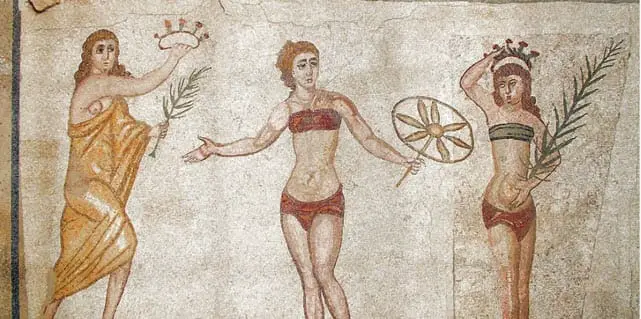
Source: Wikimedia Common
Belts being a standard accessory in ancient Greece, it was a fashion choice to use belts around the waist to cinch a chiton. They used specific belts to fasten loose-fitting chitons around the chest area, and this breast band was known as strophion.
It can also be compared to a modern-day-bra but as an outer layer rather than under the clothes. The fabric used was wool or linen wrapped across the breasts and connected among the shoulder blades.
1. Children clothes
It was common for Greek children to roam around naked, mainly at home. As for clothes, they would usually wrap a cloth around the waist.
Wearing chitons and footwear was an unusual act for the Greek children until they reached the age of going to school. However, they would begin wearing the clothes meant for adults, once they joined the school.
Chitons were large, held together by pins on the shoulders and a strap around the tail. They were made out of wool during the winter and linen during the summer.
Conclusion
The ancient Greeks embraced various clothing styles and came up with their style based on their physiology. The clothing culture had a massive impact on the numerous oldest civilizations including Roman Empire.
Western civilizations, from chitons, peploi to strophions and leather sandals, Chlamys, and cloak-like clothing, influenced Christian society. As Jesus himself portrayed a very similar cloak and veils are still prevalent in most cultures in the modern-day.
Children, however, had a fundamental idea of clothing as they mostly roamed around naked. The only clothing they wore was cloth diapers wrapped around their waist—children, when they started going to school, used to wear regular adult clothing like chitons.
